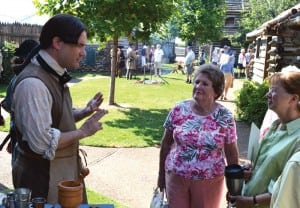Those of us who write about history sometimes fall into the trap of making the same mistake someone else made.
Here is an example that I recently discovered from Paul Clements, the researcher behind the book “Chronicles of the Cumberland Settlements:”
In spite of what many history books (including some I’ve written) say, there apparently was not a place referred to by Tennessee’s pioneers as “Fort Nashborough.”
You see, the settlers who migrated from present-day East Tennessee to Middle Tennessee in the winter of 1779-80 built several forts, one of which was located very close to the current Davidson County Courthouse. The community around that fort become formally known as Nashville in 1784.
However, in spite of what you might read in history books, the people who lived in and around that fort didn’t call it Fort Nashborough.

How do we know this? In the 1840s, a researcher named Lyman Draper came to Middle Tennessee and interviewed everyone he could find who had lived at or near the fort in the early days. According to Clements, not a single one of them ever referred to the place as Fort Nashborough.
“They called the place either ‘the fort’ or ‘the bluff’ or ‘French Lick Station’ or ‘Bluff Station,’” says Clements, who spent several years researching Draper’s interviews. “Not one time did I find anyone who actually referred to it as ‘Fort Nashborough.’”
The French Lick title came from the fact that there had been a French trading post in the area, along with a salt lick and natural spring that lured game. The “bluff” title came from the location of the fort atop a bluff on the Cumberland River.
In addition to Draper’s interviews, there is proof from letters of the time that the name Fort Nashborough wasn’t used. On Sept. 1, 1782, John Donelson, a leader in the settlement (and the father of future first lady Rachel Donelson Jackson) wrote a letter to Virginia Gov. Benjamin Harrison. It is a formal letter in which Donelson talks about the location of prospective peace talks with the Chickasaw Indian nation. “The French Lick on the Cumberland River seems to be the place where the Chickasaws wish to meet, it being the nearest settlement to their nation,” Donelson wrote.
A few months later, in another letter, settler Isaac Shelby also referred to the place as French Lick. “The French Lick ought to be the place of meeting,” Shelby wrote. “It is most central to the several tribes.”
So why did history books come to refer to it as Fort Nashborough? Because Richard Henderson, the land speculator who sent settlers to Middle Tennessee in the first place, originally wanted it to be called that.
“Henderson originally wanted it to be called Nashborough, and the name appears in the early records and in the Cumberland Compact,” says Clements. “But it never caught on.”
In 1784, the North Carolina General Assembly formally authorized the creation of a place called Nashville. At that time, they referred to the place as being “on the south side of Cumberland River, at a place called the Bluff, adjacent to the French Lick.”

There is no mention of any place known as Fort Nashborough.
It is, in a way, quite appropriate that Paul Clements came to this conclusion so recently. If it is true that Fort Nashborough didn’t exist then, it doesn’t really exist now, either!
You see, Nashville once had a vibrant representation of its original fort. Built in the 1930s, the replica was called Fort Nashborough, featuring living history events, an employee whose job it was to put them on and a cadre of volunteers who greeted visitors at the gate. Fort Nashborough was one of Nashville’s main tourist attractions, along with the Parthenon, the Hermitage and the Grand Ole Opry.
However, the staffed position at the Fort Nashborough replica was eliminated during the late 1980s and never restored. The condition of the fort deteriorated, visits from school groups sharply declined and it became a place where people loitered.
Nearly four years ago, the Metro Parks Department closed down the replica of the fort because of environmental reasons. Since that time, the place has been closed off to the public (something you won’t read about in Chamber of Commerce literature about Nashville.)
The Metropolitan Government of Nashville hired a consultant to come up with a plan for the Fort Nashborough site. That plan called for the current fort to be torn down and replaced with a series of structures and exhibits that will represent frontier life in early Nashville. But, two years later, the plan is only partially funded, and nothing has been done on the site yet.
For several years now, the local history community in Nashville has been concerned about the future of the site. Andrew Ward, founding member of the living history group known as the Cumberland Brigade, is one of them. “The fort was neglected terribly for years, and now it is a really sad thing for Nashville that it has been closed for good,” he says.
“The early settlement of Nashville was a major leap westward — and a brave leap westward,” Ward says. “We are too good of a city to not honor these people and what they went through.”
Nashville is in the early stages of a mayoral race. It will obviously be up to the person who is elected as to whether Nashville will continue to have a replica of its original fort.
It will also be up to the new mayor to decide what to call it.



